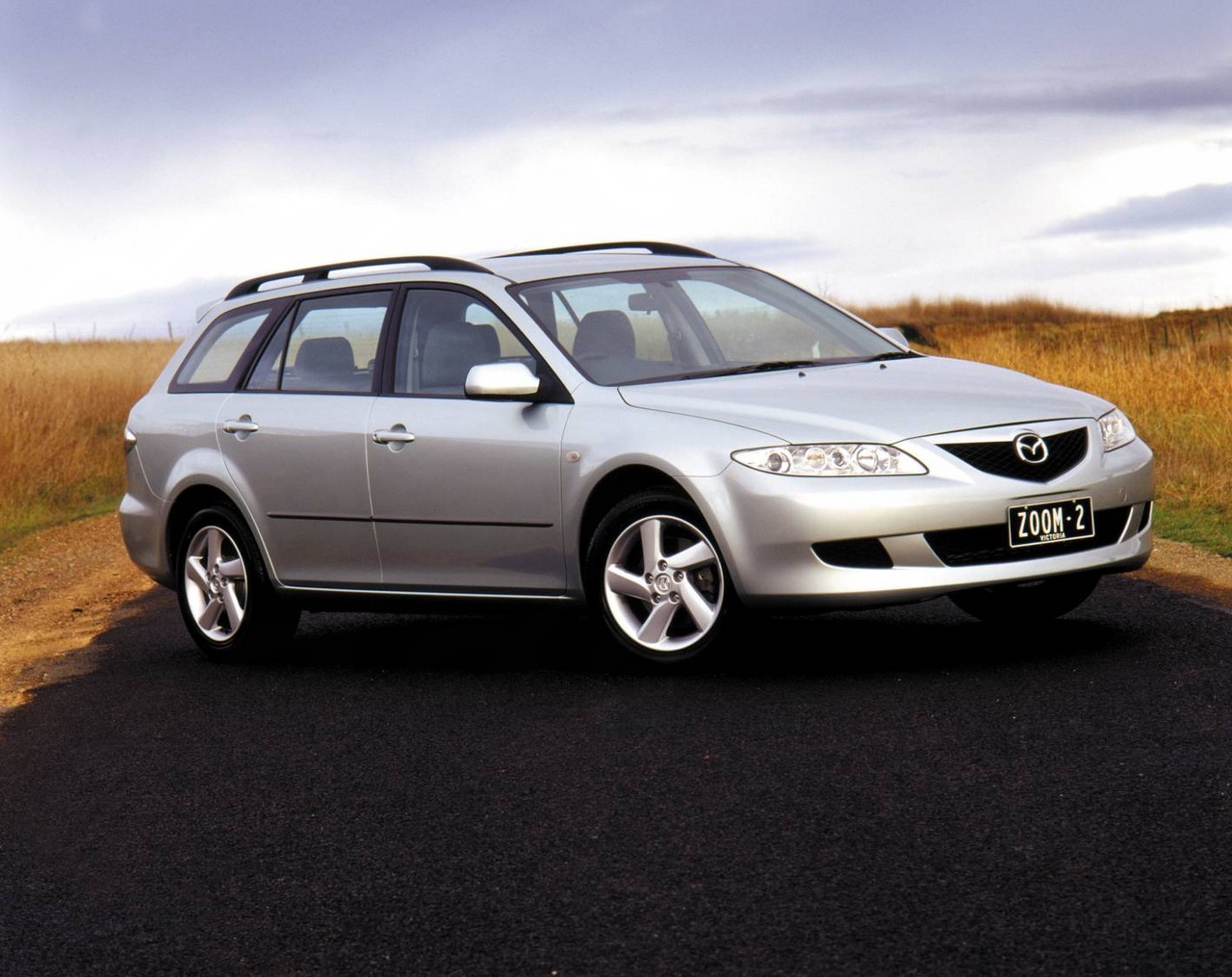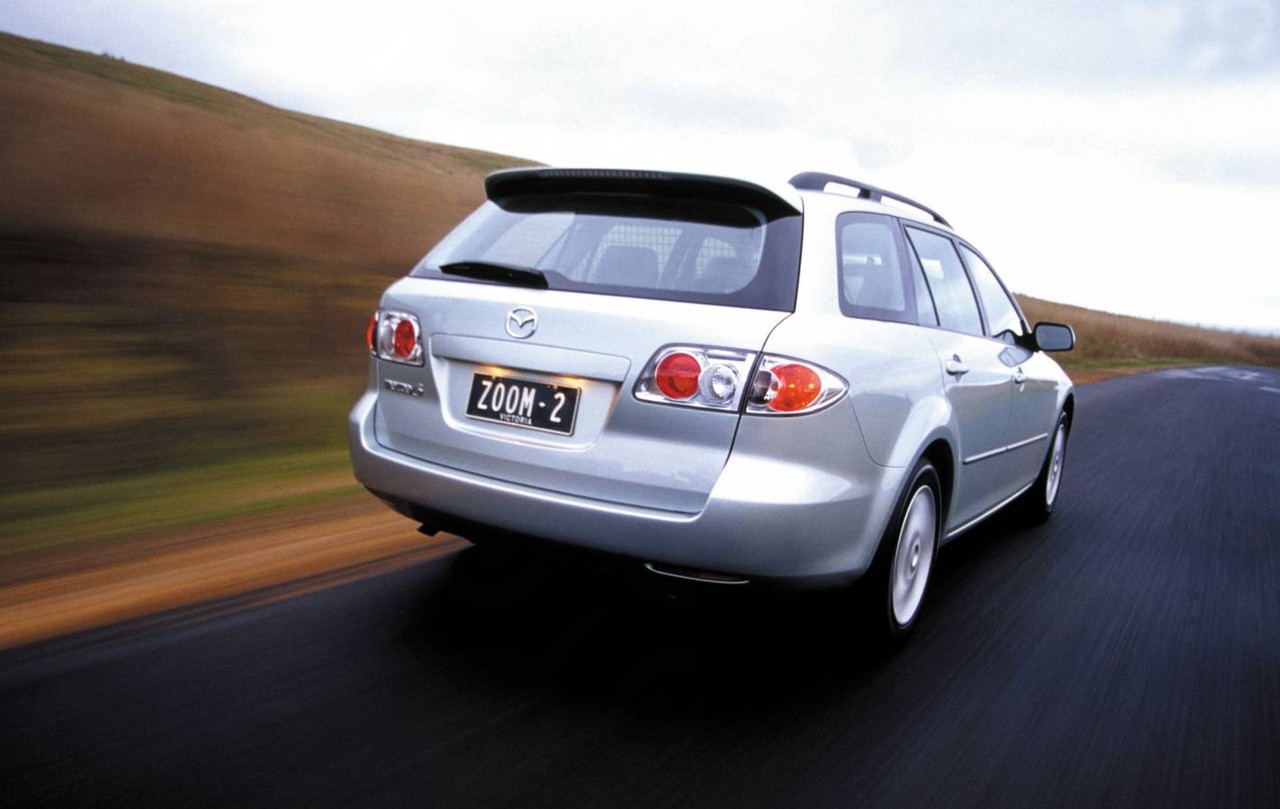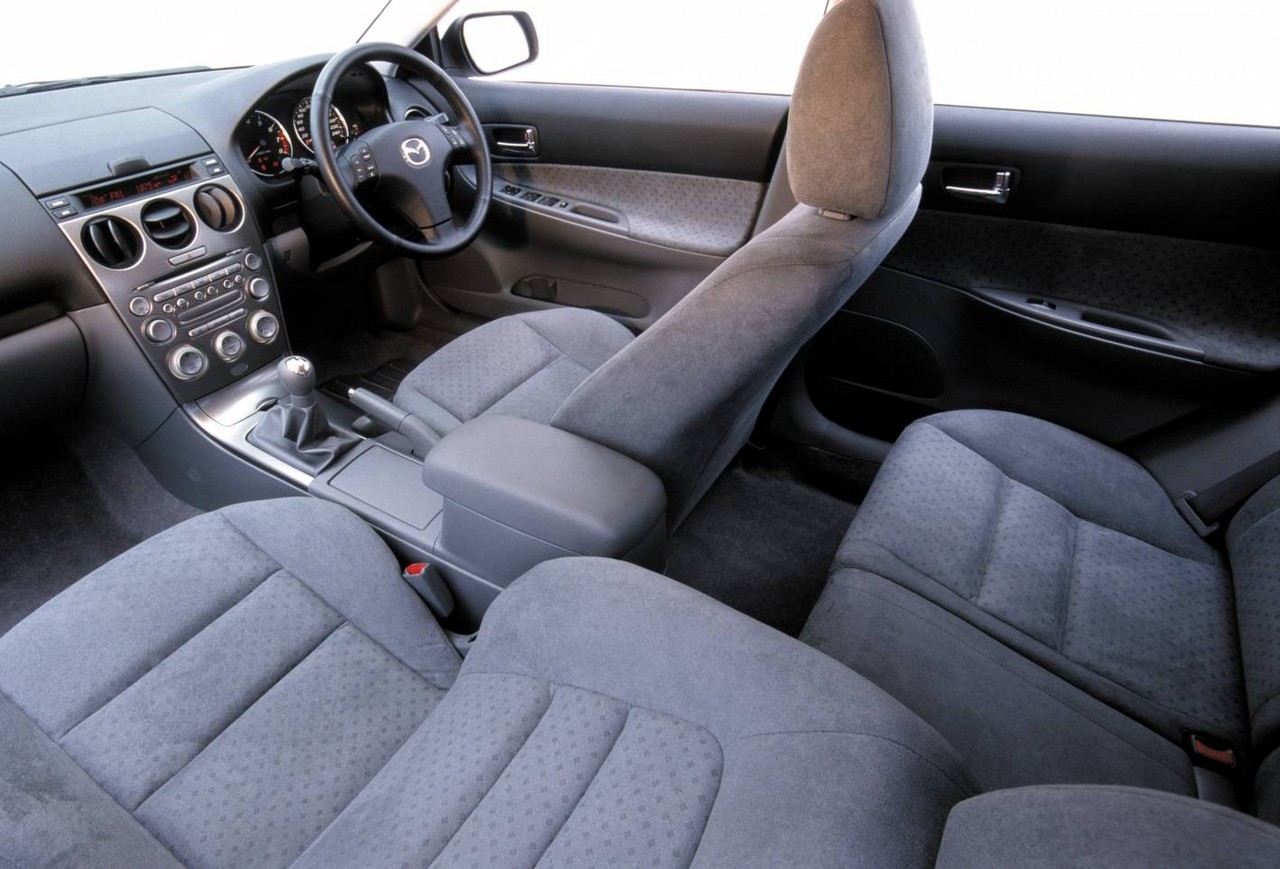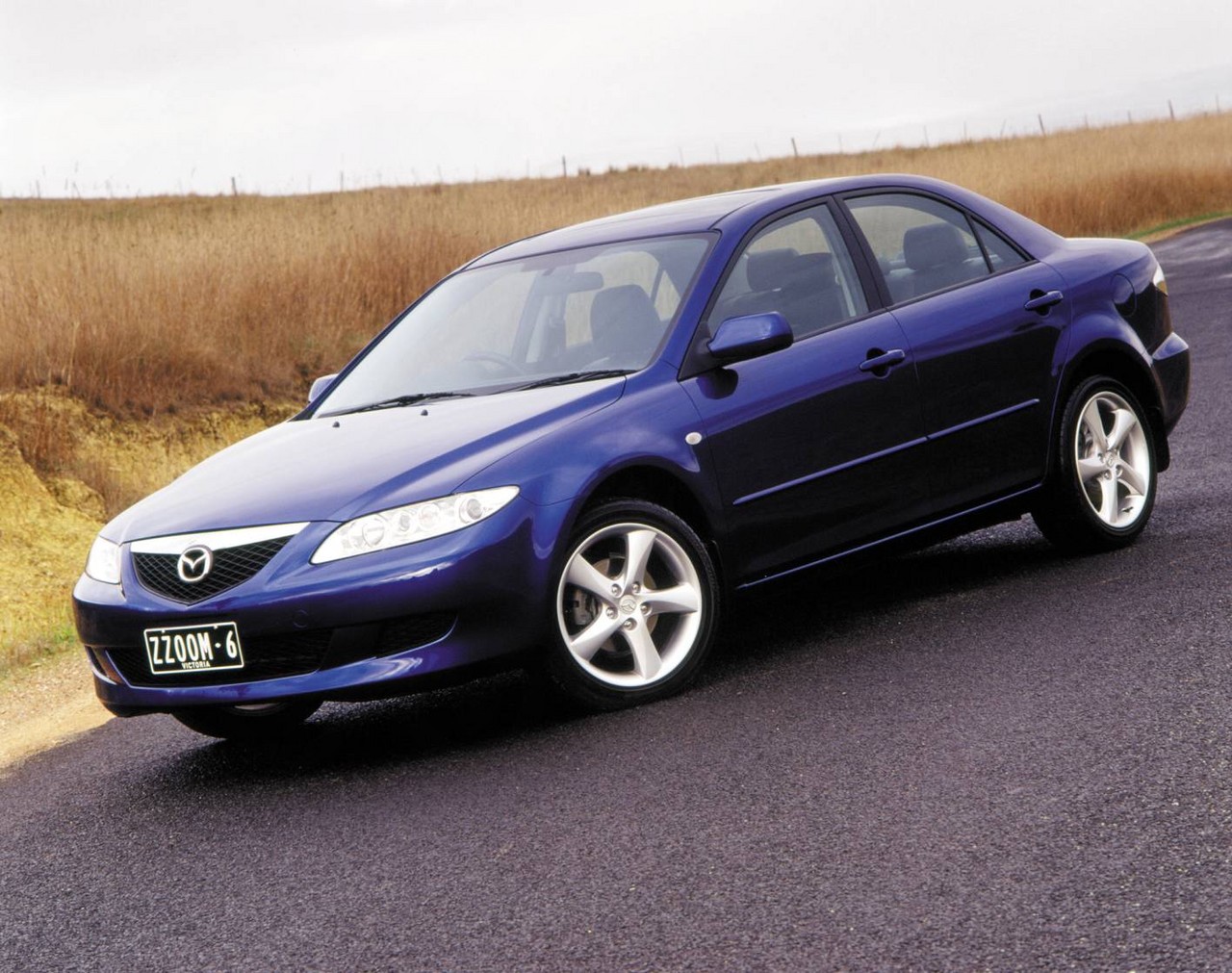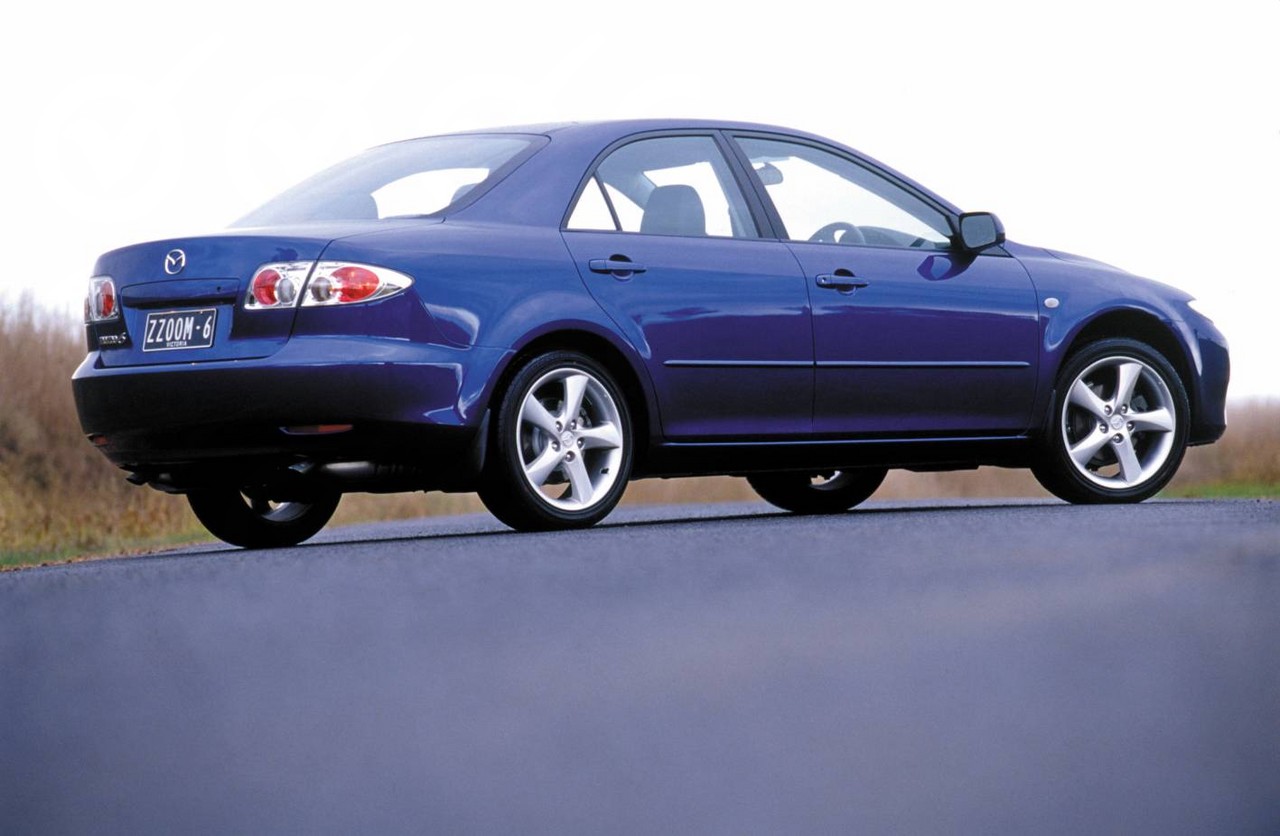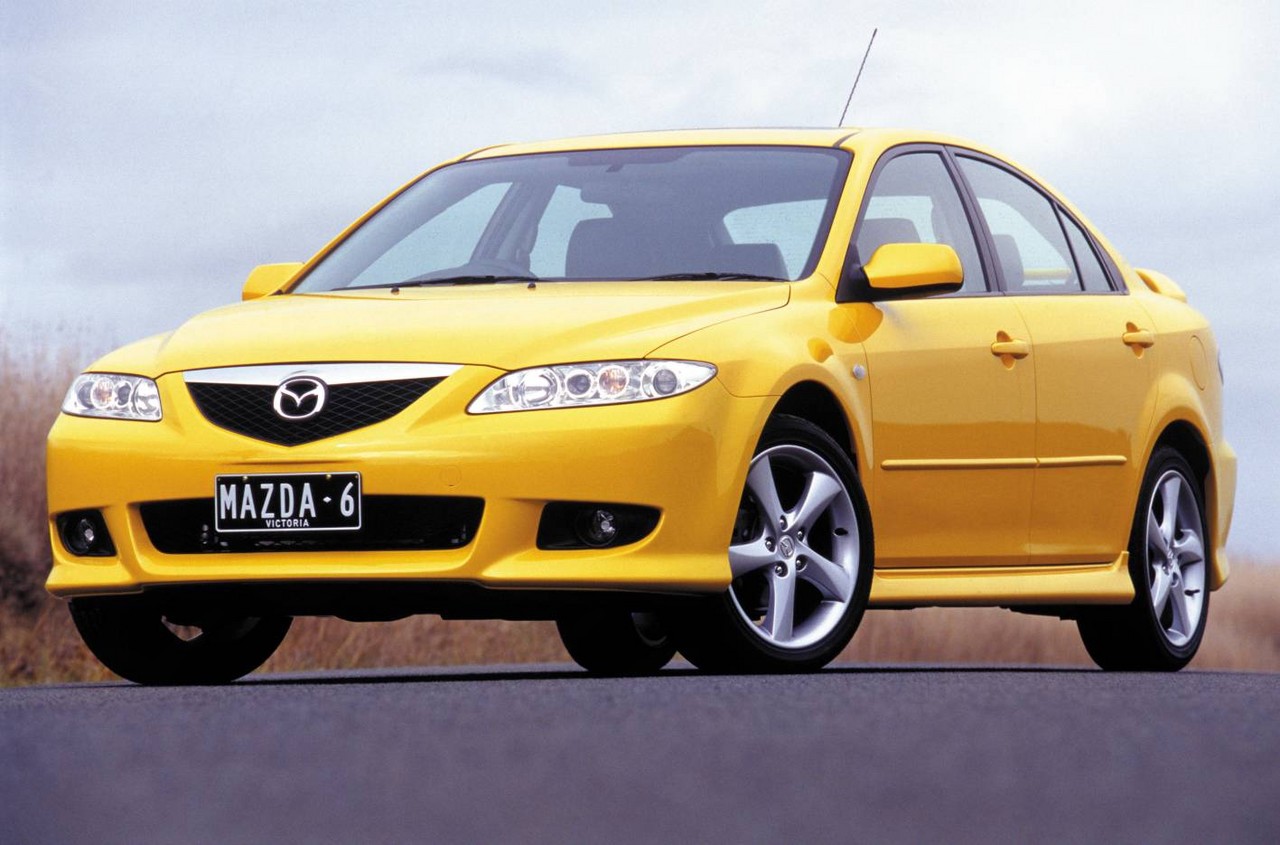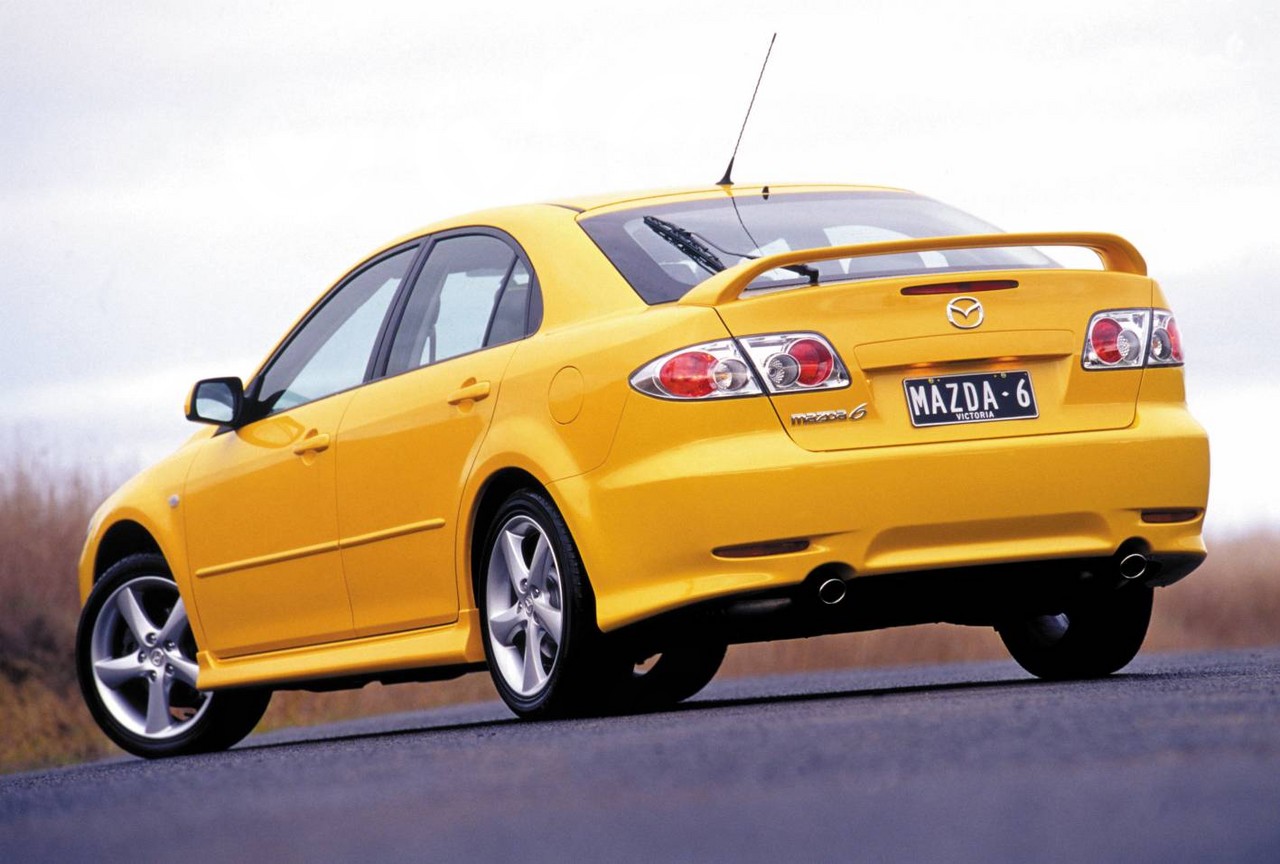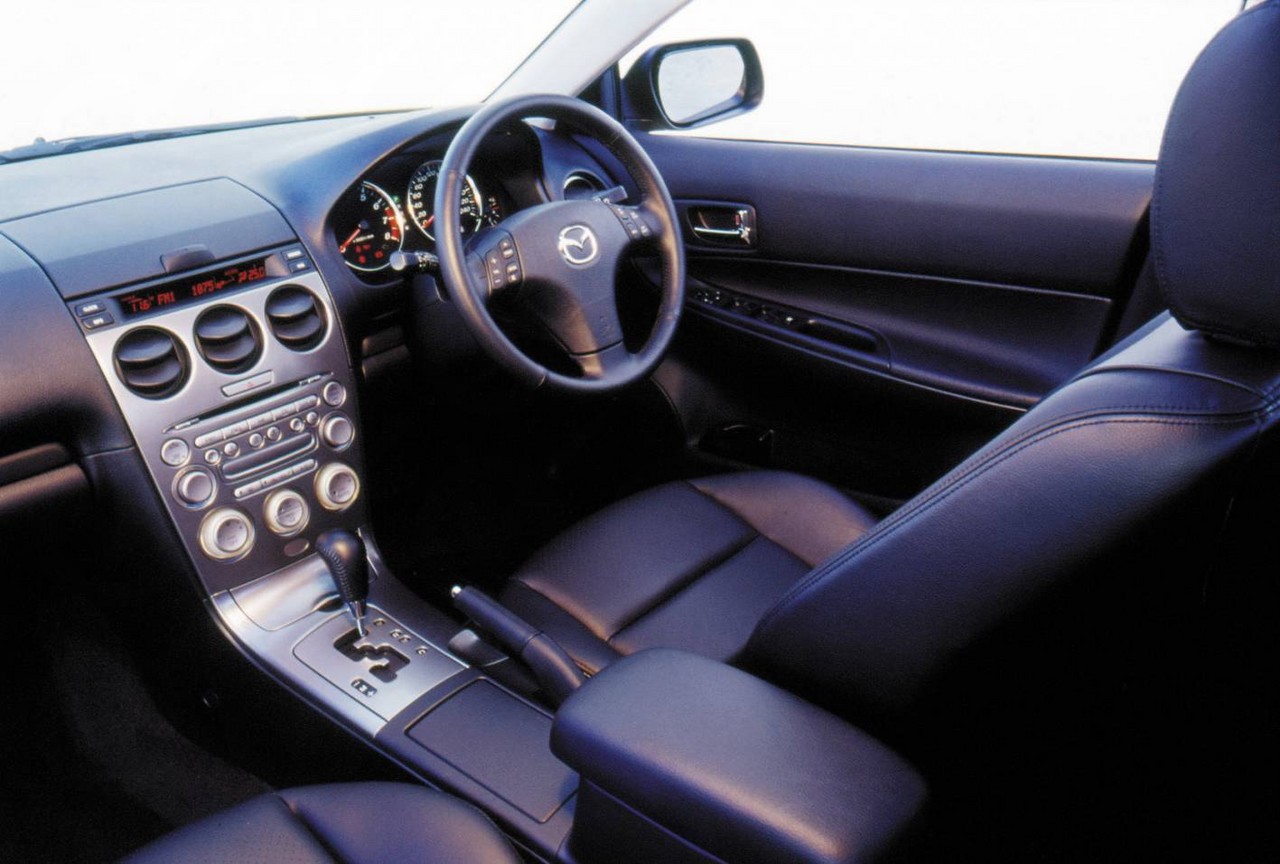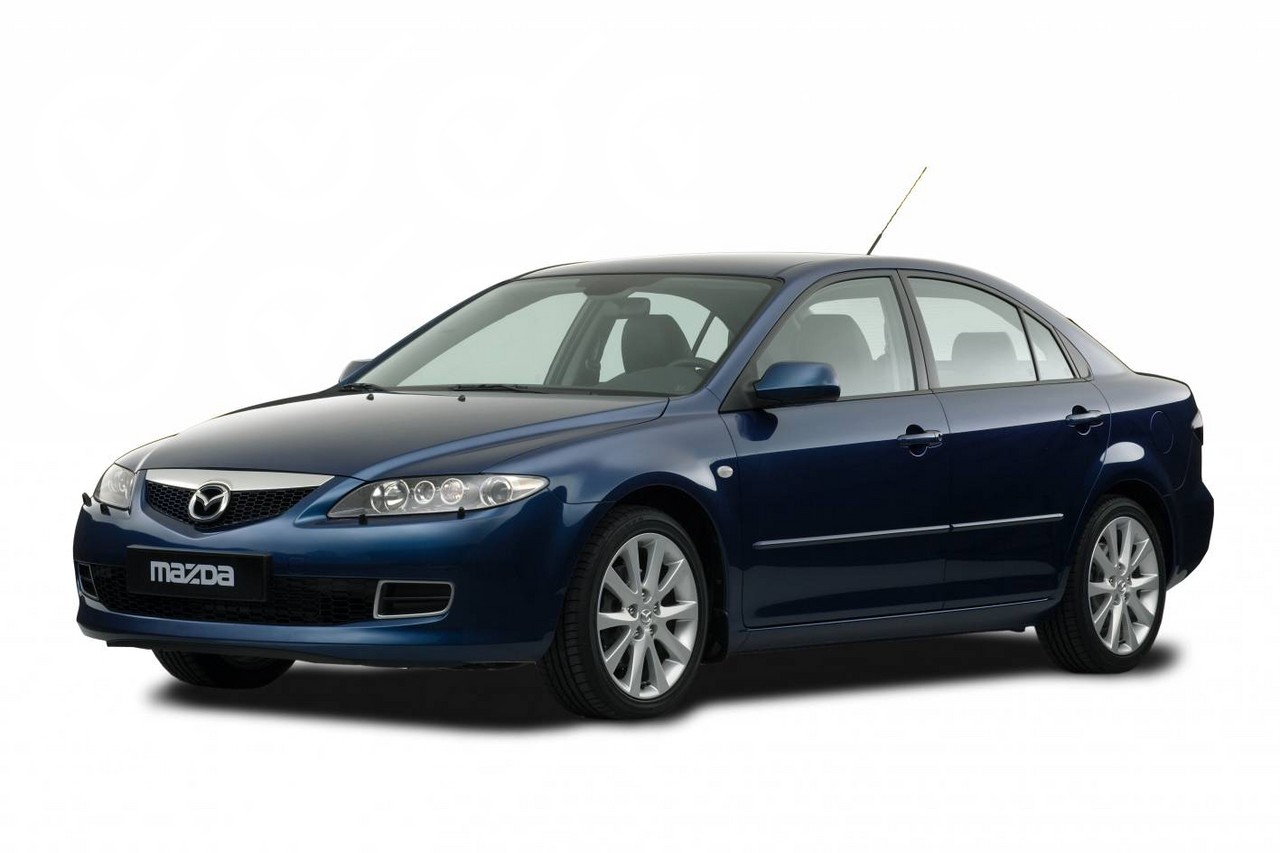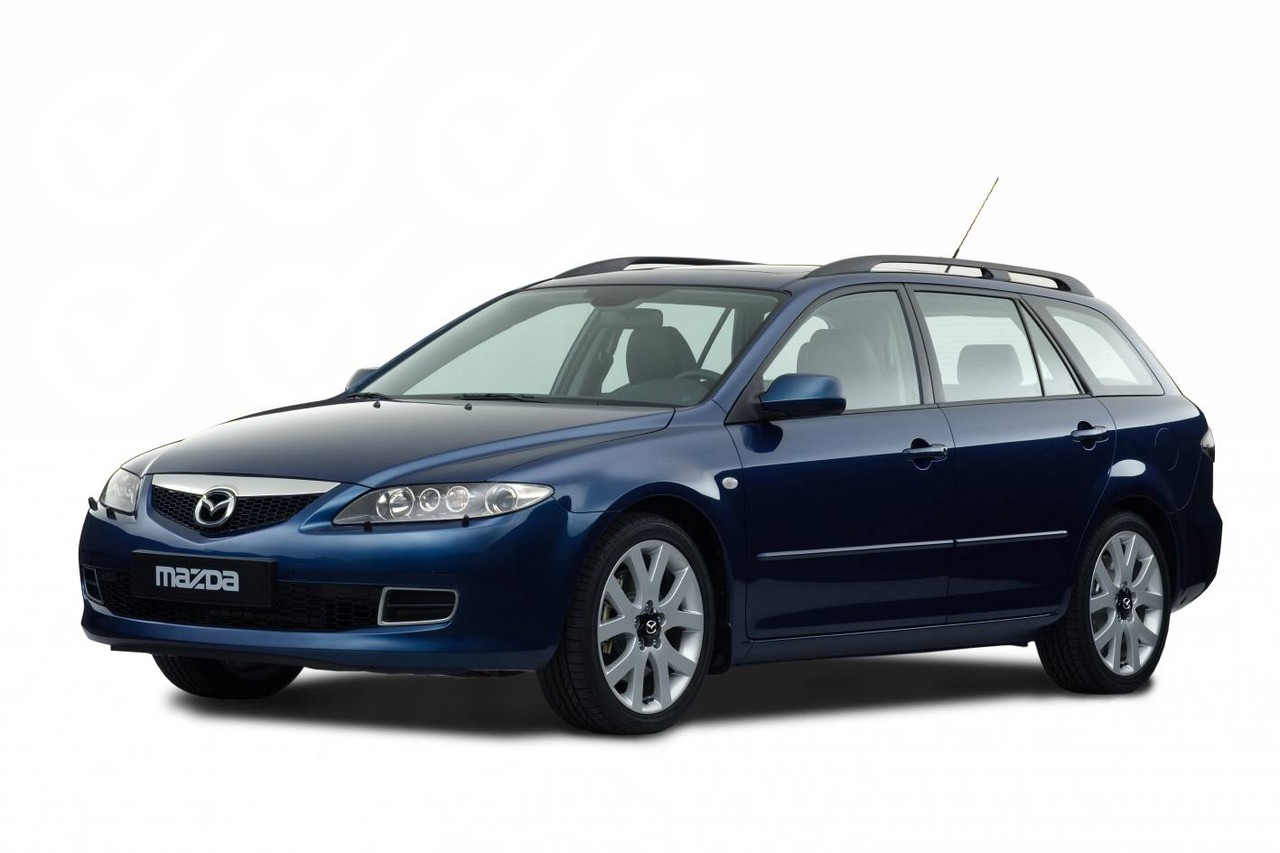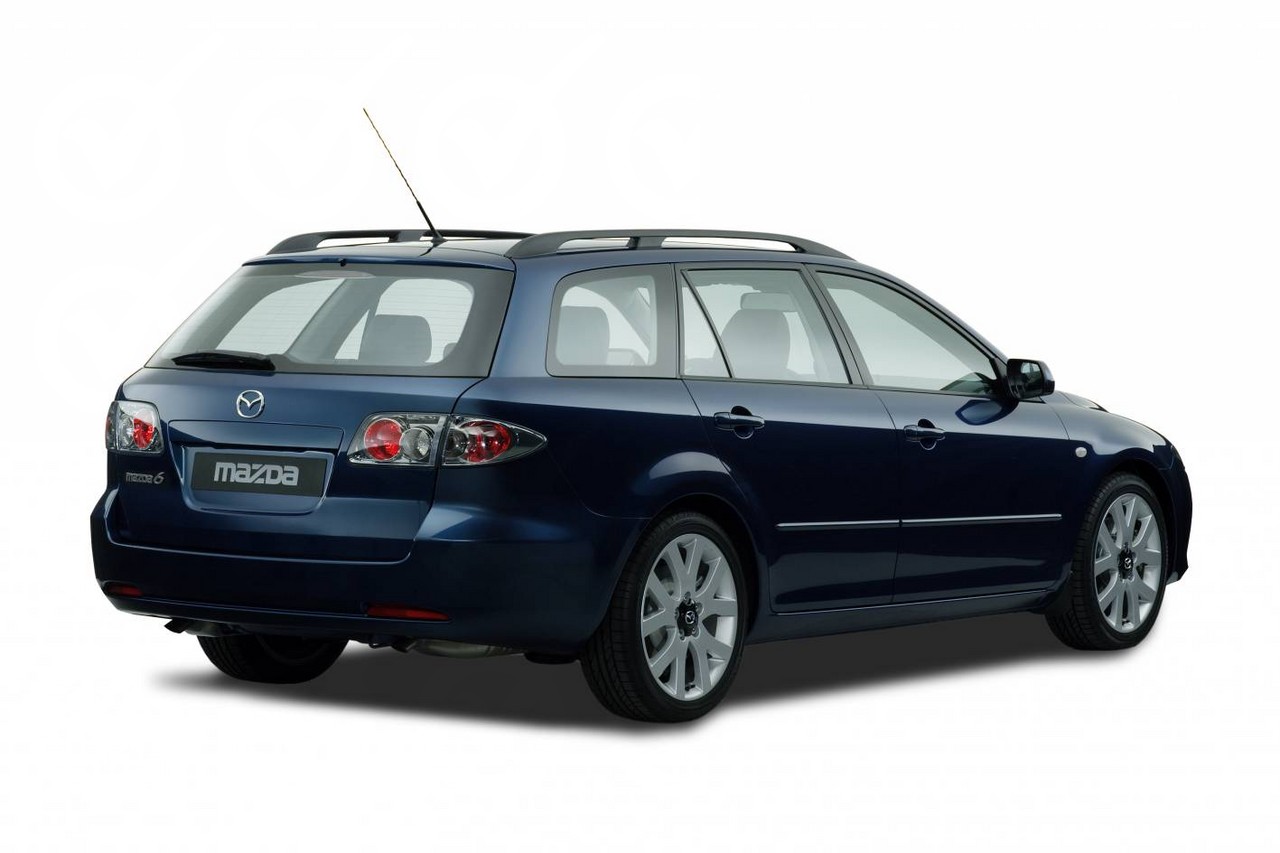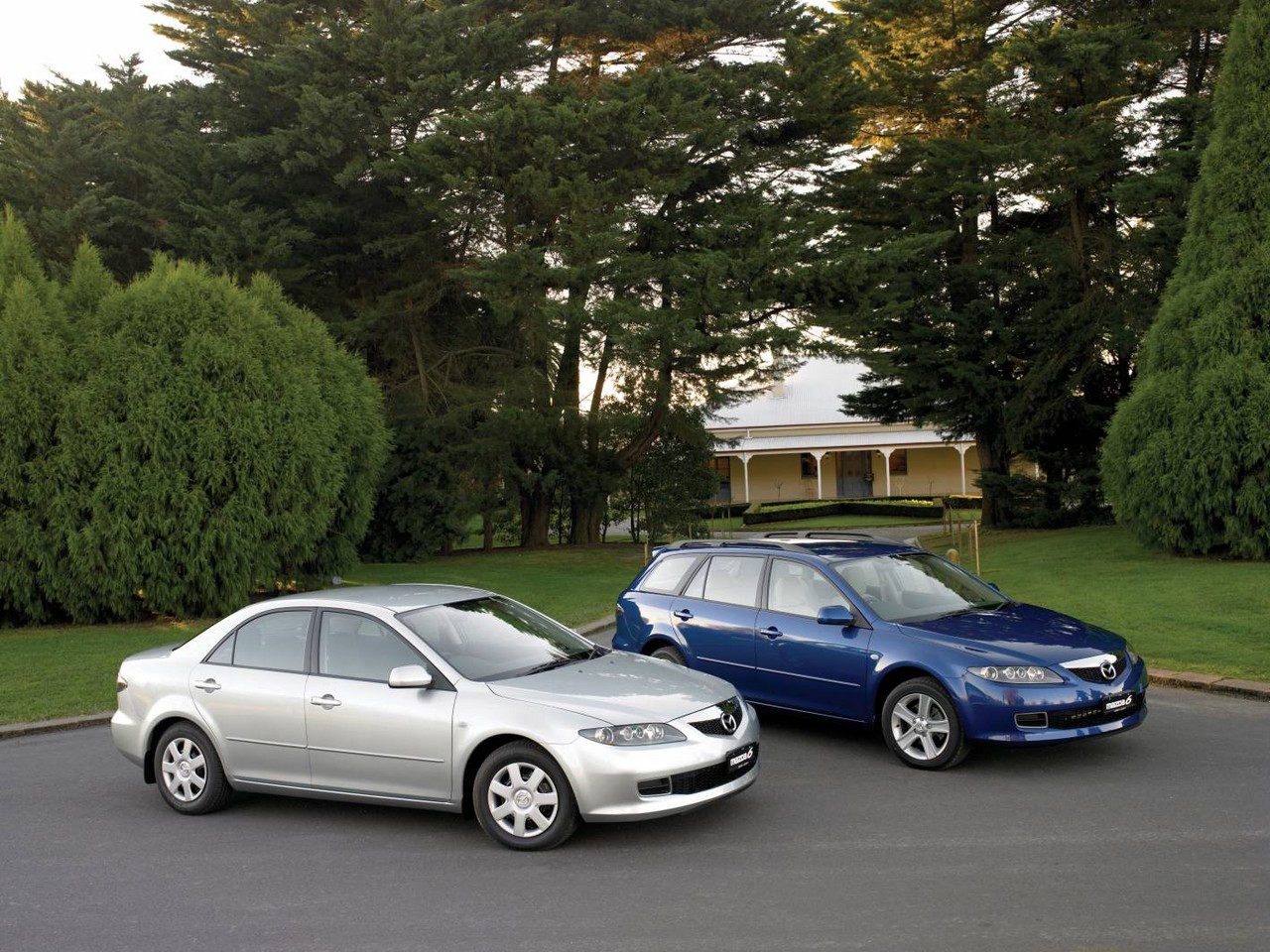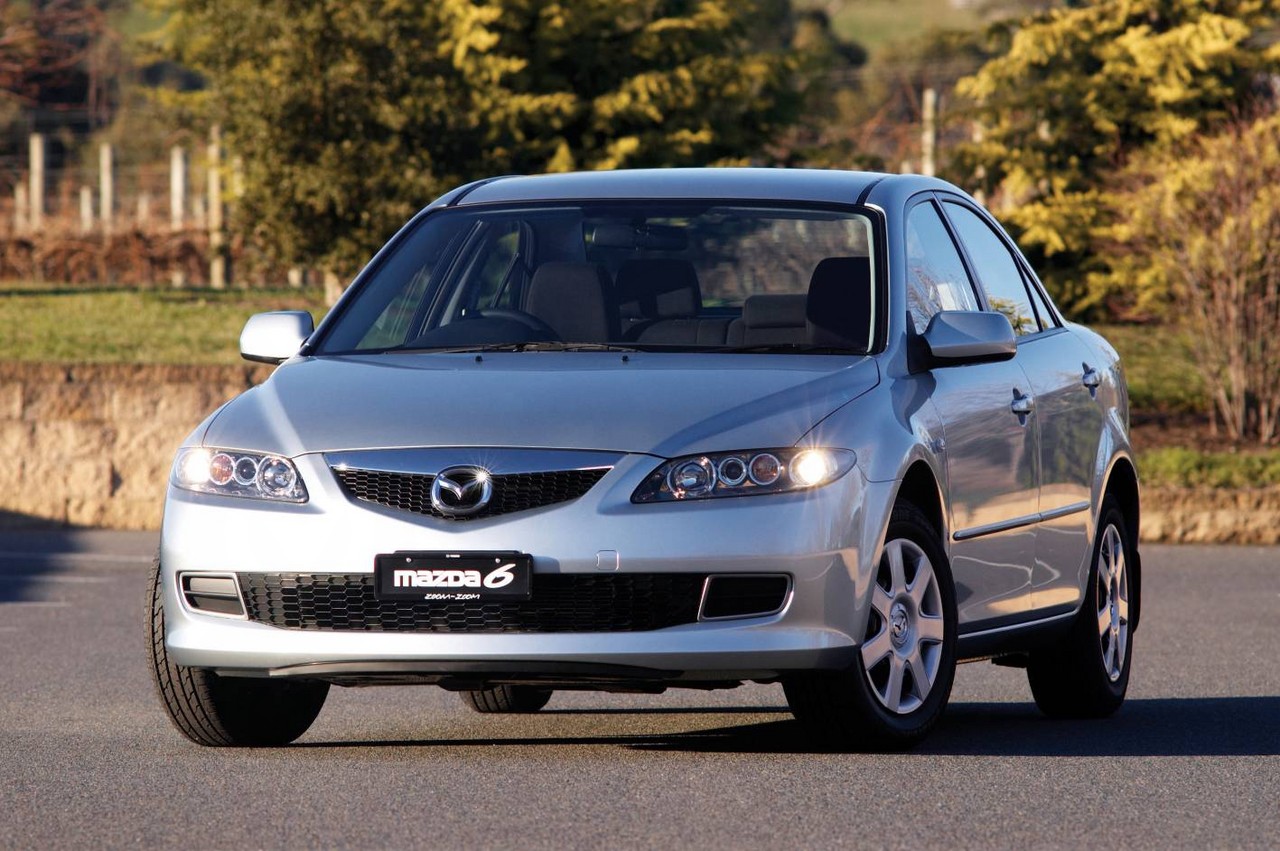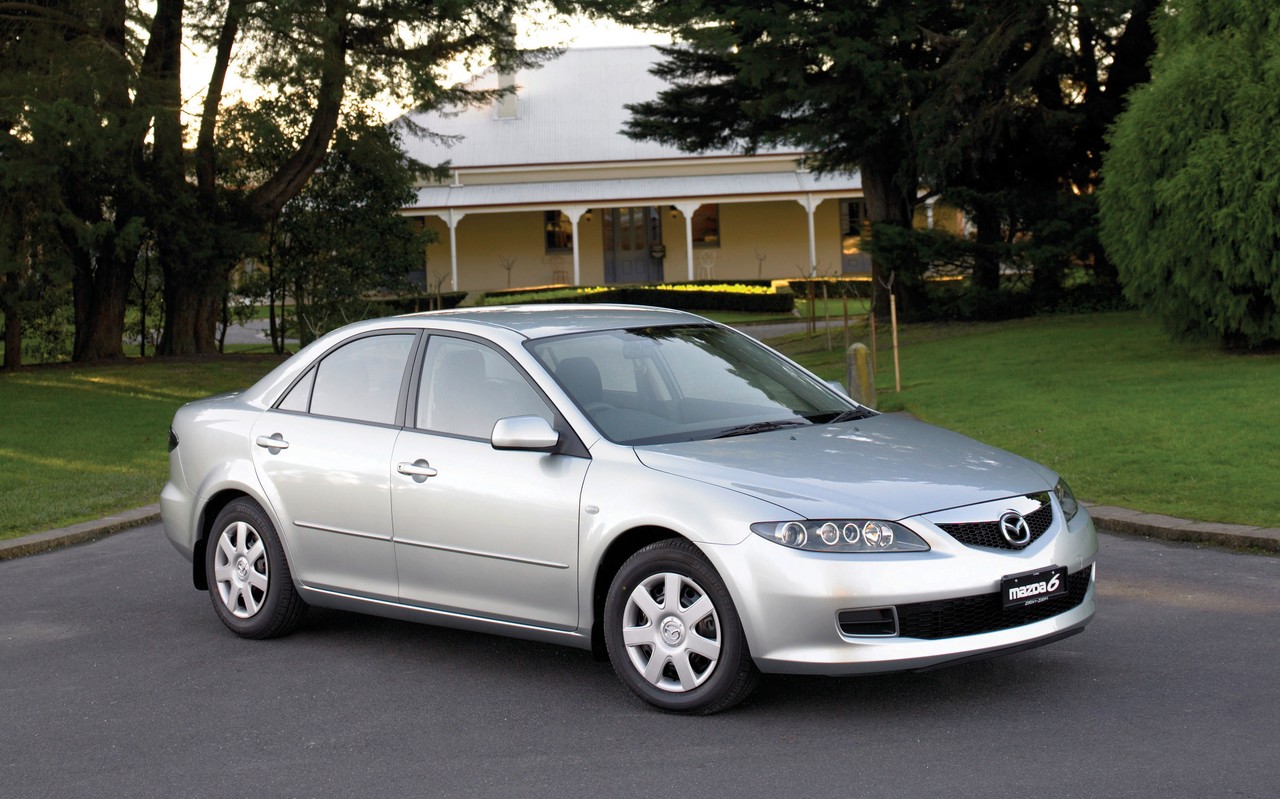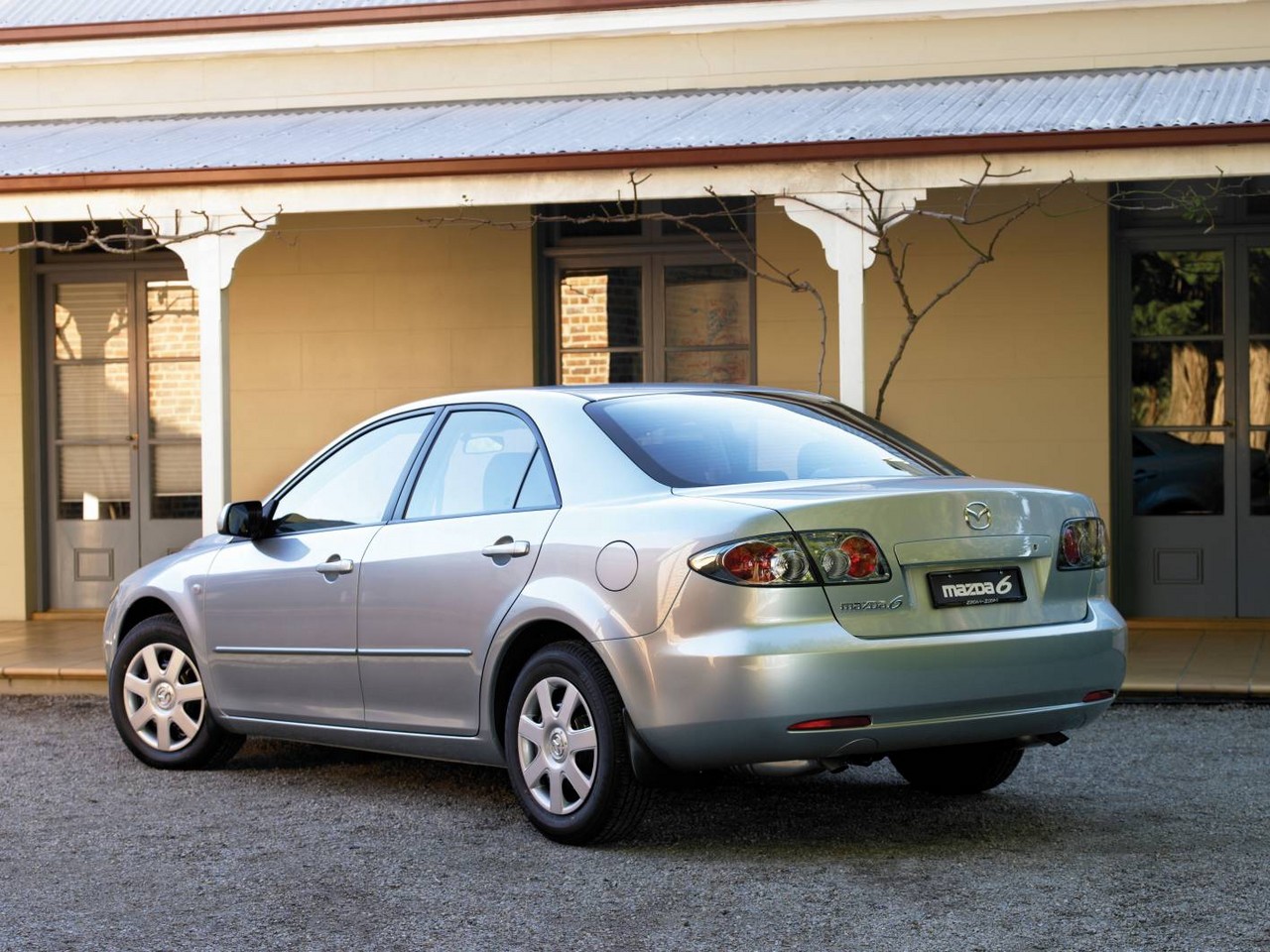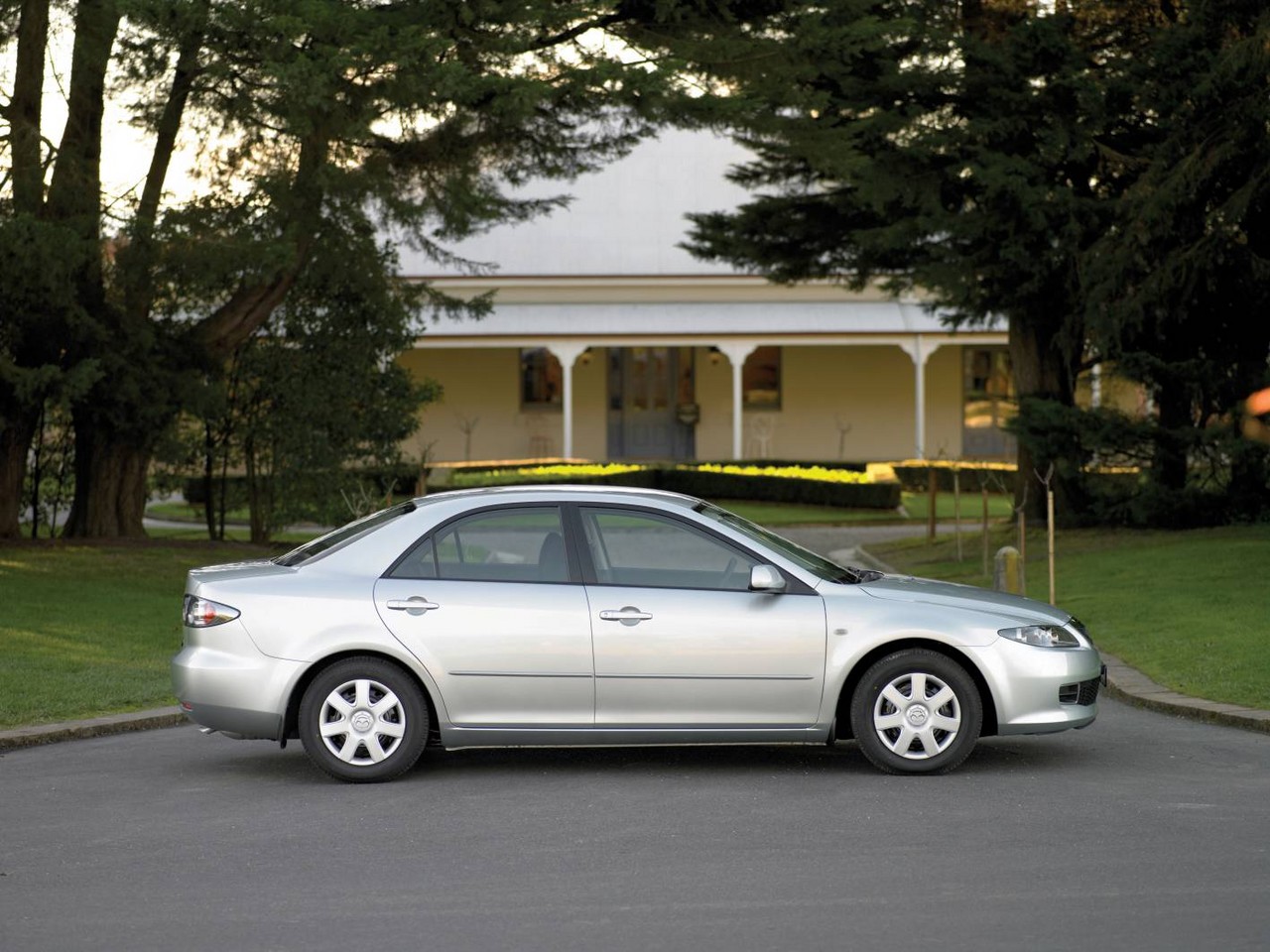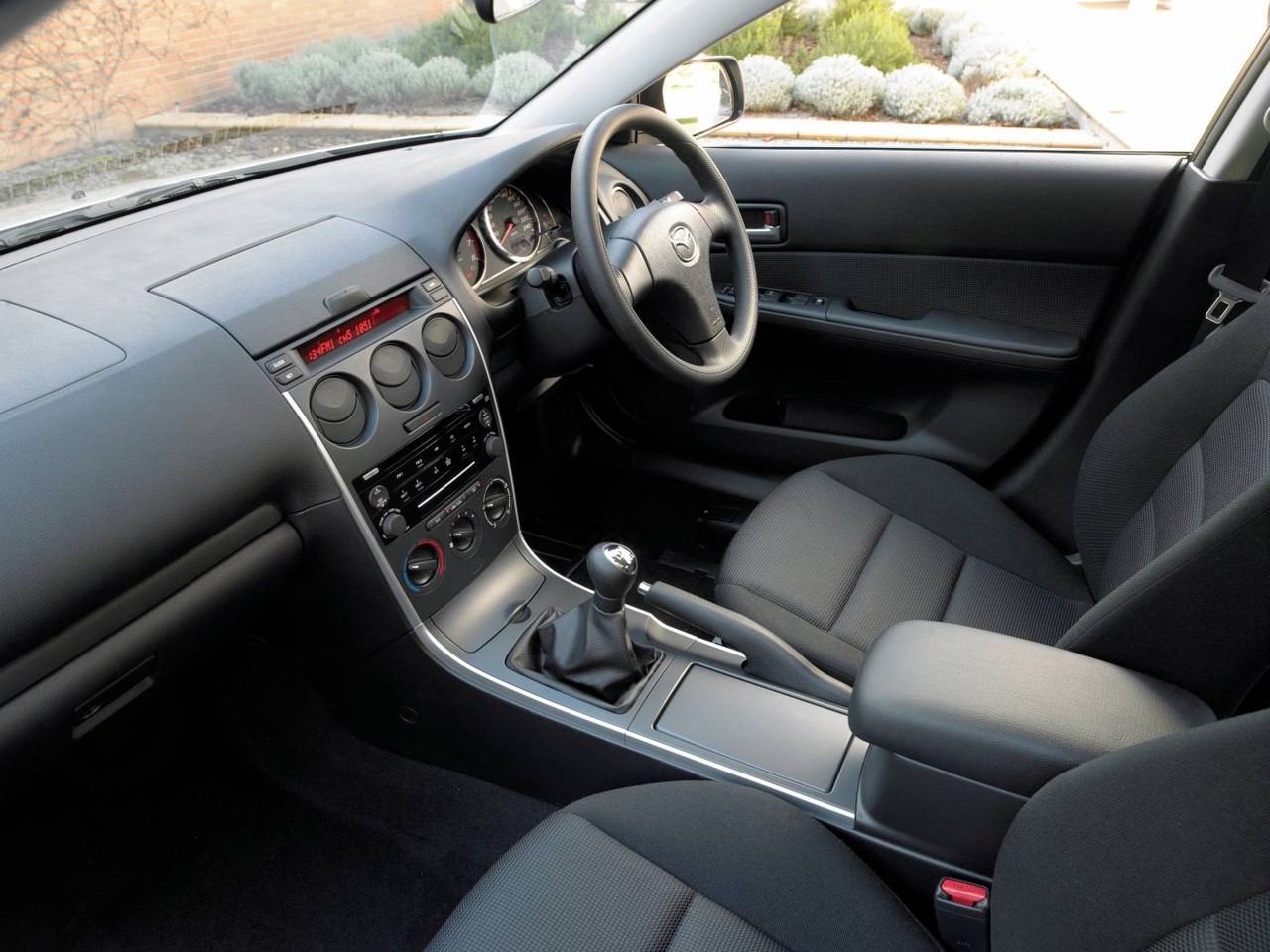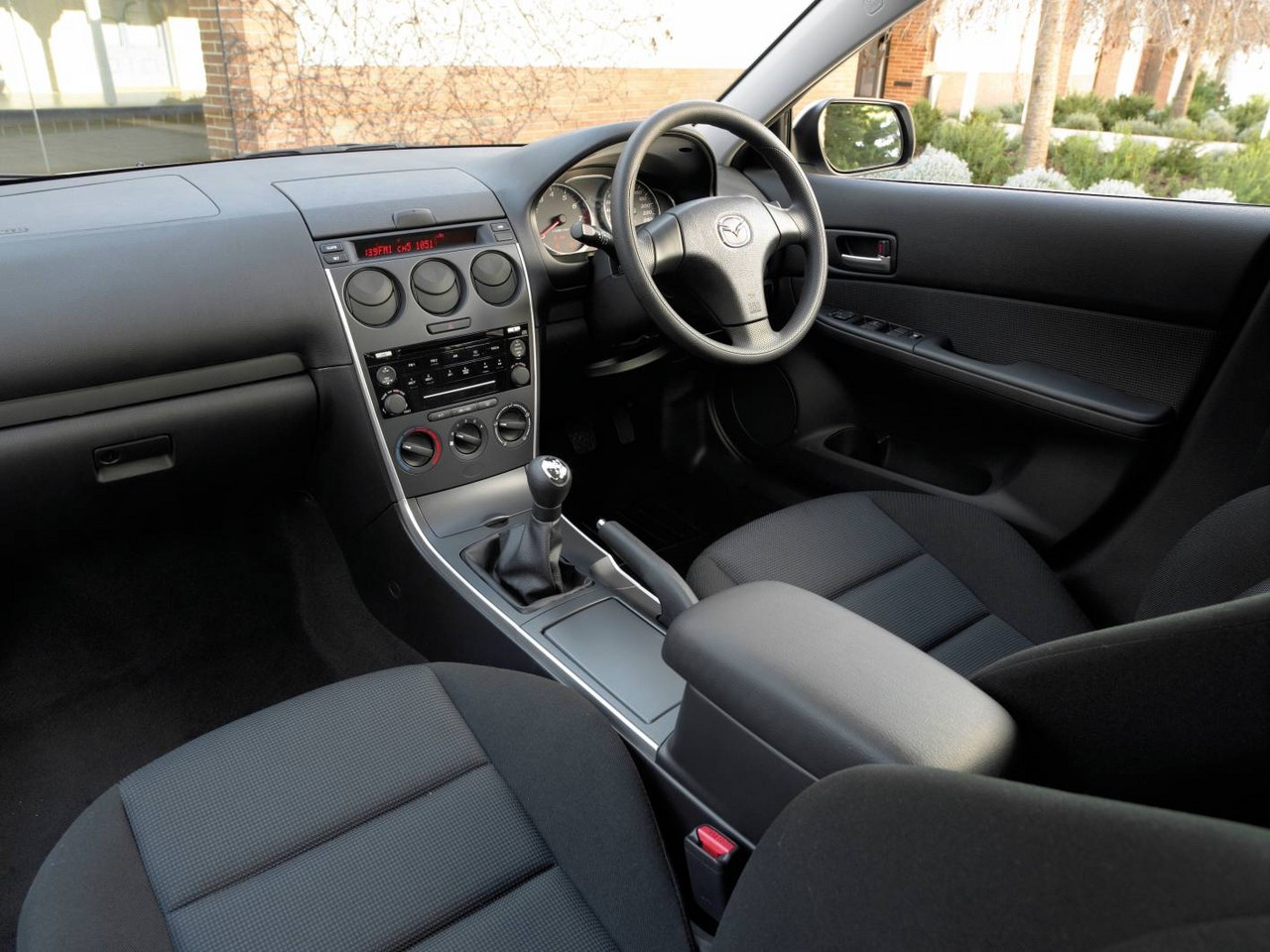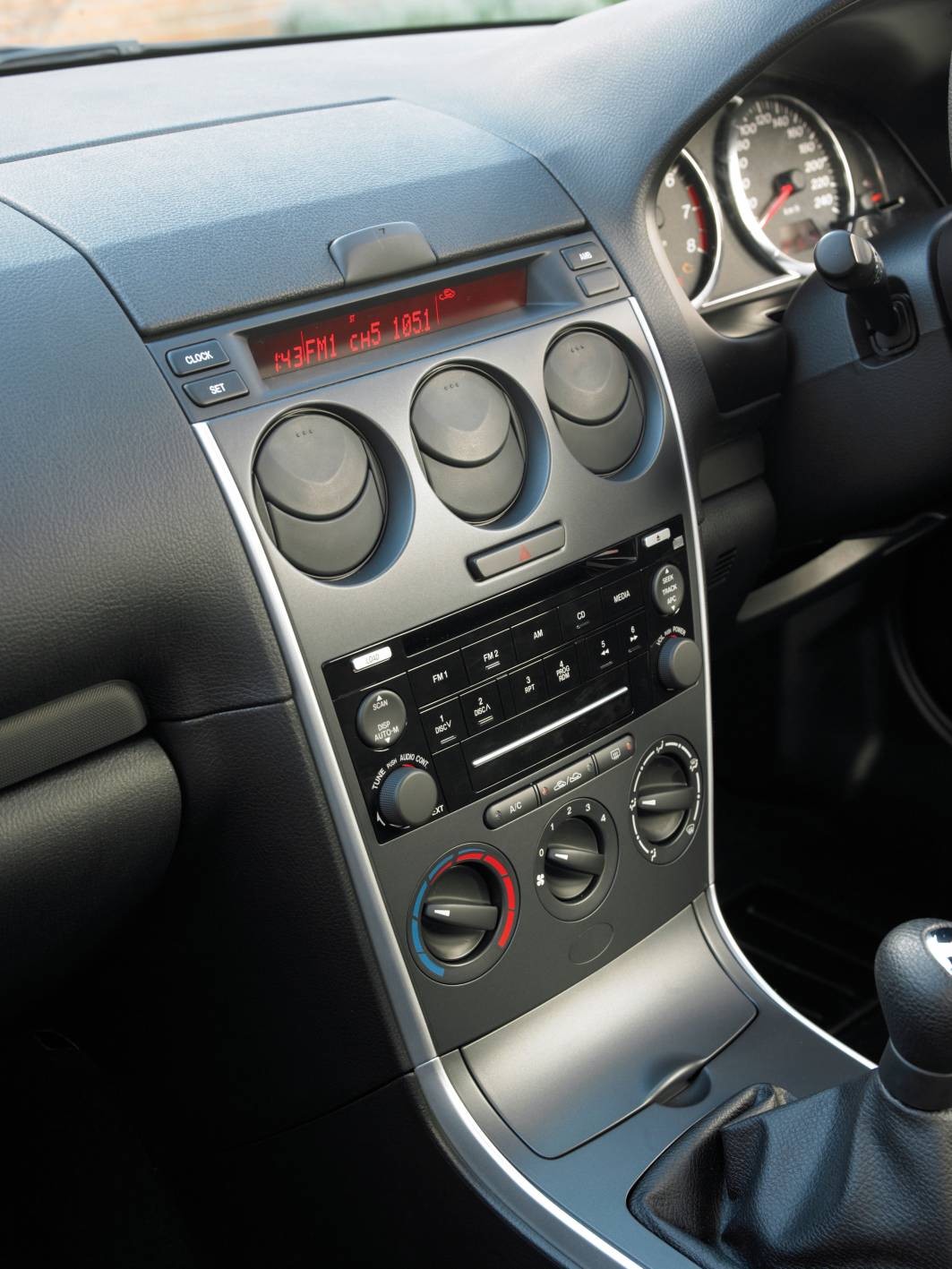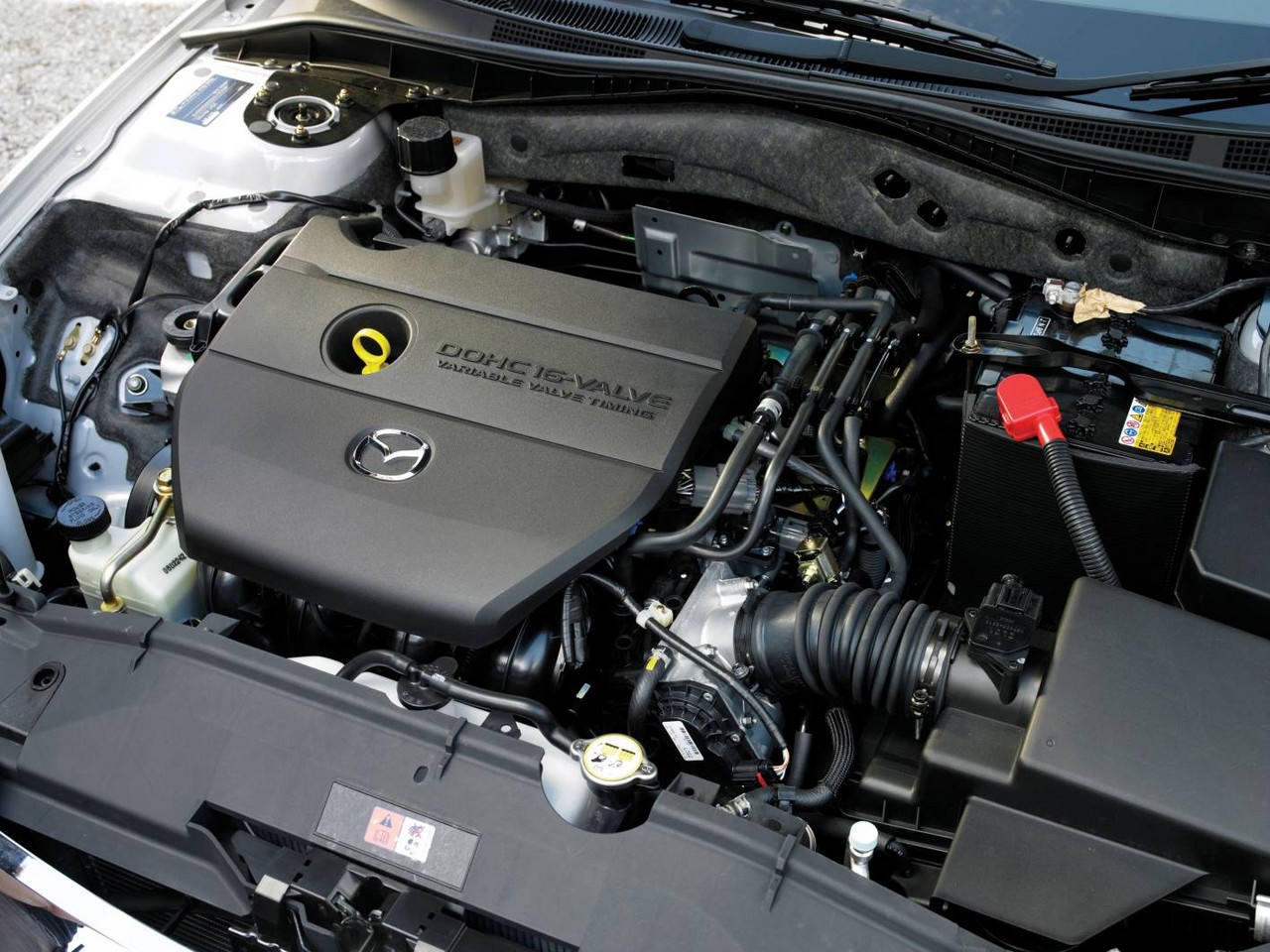
- Willing 2.3-litre petrol engine
- Responsive 2.0-litre turbo-diesel engine
- Accurate steering
- Generally impressive ride/handling balance…
- … but suspension lacks low-speed compliance
- Cabin lacks sound insulation
- Liftback has poor rear seat headroom
Review: Mazda GG.I and GY.I Mazda6 (2002-05)
Overview
Released in August 2002, the Mazda GG Series I and GY Series I (GG.I and GY.I) Mazda 6 was available as a sedan, liftback and wagon. Manufactured in Japan, the front-wheel drive Mazda GG.I and GY.I Mazda6 were powered by newly developed 2.3-litre four-cylinder petrol engines. As per the table below, the Mazda6 range consisted of Limited, Classic, Luxury and Luxury Sports variants.
L3-VE engine
The 2.3-litre L3-VE (or MZR) engine had an aluminium block and cylinder head, double overhead camshafts, four valves per cylinder, variable intake valve timing (Mazda’s Sequential Valve Timing, or S-VT), four valves per cylinder and a compression ratio of 10.6:1. The engine was also fitted with a balance shaft that would spin at twice the speed of the crankshaft to offset the secondary inertia force of the crankshaft.
The L3-VE engine was mated to four-speed 4F27E automatic or five-speed G35M-R manual transmissions.
Dimensions
Compared to their GF/GW 626 predecessors , the GG Mazda6 sedan and liftback were 80 mm longer (at 4670 mm), 70 mm wider (1780 mm), 5 mm taller (1435 mm) and had 65 mm longer wheelbases (2675 mm). Compared to the GG sedan and liftback, the GY Mazda6 wagon was built on the same wheelbase, but was 20 mm longer (4690 mm) and 45 mm taller (1480 mm).
Suspension
The GG and GY Mazda6 had double wishbone front suspension with MacPherson struts, coil springs and double-acting shock absorbers, and independent ‘E-Type’ multi-link rear suspension with MacPherson struts, low profile springs and double-acting shock absorbers.
| Body | Variant | Engine | Trans. | Peak power | Peak torque |
|---|---|---|---|---|---|
| Sedan (GG) | Limited, Classic, Luxury |
2.3-litre L3-VE petrol I4 | 4sp auto, 5sp man. |
122 kW at 6500 rpm | 207 Nm at 4000 rpm |
| Wagon (GY) | Classic | 2.3-litre L3-VE petrol I4 | 4sp auto | 122 kW at 6500 rpm | 207 Nm at 4000 rpm |
| Liftback (GG) | Classic, Luxury, Luxury Sports |
2.3-litre L3-VE petrol I4 | 4sp auto, 5sp man. |
122 kW at 6500 rpm | 207 Nm at 4000 rpm |
Safety equipment
Standard safety equipment for the Mazda6 Limited and Classic included dual front airbags, ABS, electronic brake force distribution and front seatbelts with pretensioners and load limiters. The Luxury and Luxury Sports variants were further equipped with front side airbags and full-length curtain airbags (i.e. for front and rear occupants).
From January 2004, the Mazda6 was fitted with front side airbags and curtain airbags as standard across the range.
Brakes
The GG and GY Mazda6 had 274 mm by 24 mm vented front disc brakes and 280 mm by 10 mm solid rear disc brakes.
Euro NCAP crash testing
In Euro NCAP crash testing , a GG.I Mazda6 liftback – fitted with dual front, front side and curtain airbags – received a four star adult occupant protection rating with a score of 26.27 out of 37. In the frontal offset crash test, the footwell deformed and protection from serious leg injury was marginal for the driver. In the side impact test, there was a moderate risk of serious chest injury for the driver.
Features: Mazda6 Limited, Classic and Luxury
Standard features for the Mazda6 Limited included 15-inch steel wheels, a four speaker 100 watt sound system with CD player, air conditioning, remote central locking, power mirrors and windows, a tilt adjustable steering wheel, height adjustable driver’s seat and an immobiliser.
While the sedans were fitted with 60/40 split and folding rear seats, the liftback and wagon models had Mazda’s ‘Karakuri’ system whereby the rear seats could fold forward to create a flat loading floor by operating a lever in the side of the boot. Wagon models were also fitted with a retractable cargo net and roof rails.
Compared to the Limited variants, the Mazda6 Classic was further equipped with 16-inch alloy wheels, a six-disc in-dash CD player, climate control air conditioning, driver’s seat lumbar adjustment, velour upholstery, cruise control, front fog lamps, a leather-wrapped steering wheel (with sound system and cruise control buttons) and trip computer.
The Mazda6 Luxury was distinguished by its 17-inch alloy wheels, seven speaker 200 watt Bose sound system with subwoofer, a four-way power adjustable driver’s seat, leather seat trim, a leather-wrapped steering gearshift and power sunroof. Finally, the Mazda6 Luxury Sports was fitted with a sports body kit which included a rear spoiler, side skirts and driving lights.
Related links
Review: Mazda GG.II and GY.II Mazda6 (2005-07)
Overview
Released in August 2005, the GG and GY Series (GG.II/GY.II) Mazda 6 range introduced a revised line-up, greater refinement and retuned suspension. Mechanically, the 2.3-litre four-cylinder petrol models featured electronic throttle control and new five-speed FS5A-EL automatic and six-speed manual transmissions. Visually, the GG.II/GY.II Mazda6 could be identified by its more aggressive grille with honeycomb mesh, new bumpers and black-bezelled headlights.
The GG.II and GY.II Mazda6 range was subsequently expanded with Diesel variants in October 2006; the Mazda6 range also underwent a minor update in May 2007.
Mazda6 Diesel
For the Mazda6 Diesel, the 2.0-litre MZR-CD RF 2005 four-cylinder diesel engine had a cast iron block, an aluminium cylinder head, common-rail direct injection (operating at 180 MPa), a variable geometry turbocharger, intercooler, a single overhead camshaft (belt-driven), four valves per cylinder, a compression ratio of 16.7:1 and a diesel particulate filter.
The Mazda6 Diesel was solely available with a six-speed A26MX-R manual transmission.
| Body | Variant | Years | Engine | Trans. | Peak power | Peak torque |
|---|---|---|---|---|---|---|
| Sedan | Classic | 2005-07 | 2.3-litre L3-VE petrol I4 | 5sp auto, 6sp man. |
122 kW at 6500 rpm | 207 Nm at 4000 rpm |
| Limited | 2005-07 | |||||
| Sports | 2007 | |||||
| Luxury | 2005-07 | 2.3-litre L3-VE petrol I4 | 5sp auto | |||
| Wagon | Classic | 2005-07 | 2.3-litre L3-VE petrol I4 | 5sp auto | 122 kW at 6500 rpm | 207 Nm at 4000 rpm |
| Sports | 2007 | |||||
| Diesel | 2007 | 2.0-litre MZR-CD RF 2005 turbo-diesel I4 | 6sp man. | 105 kW at 3500 rpm | 360 Nm at 2000 rpm | |
| Liftback | Classic | 2005-07 | 2.3-litre L3-VE petrol I4 | 5sp auto, 6sp man. |
122 kW at 6500 rpm | 207 Nm at 4000 rpm |
| Classic Sports | 2007 | |||||
| Sports | 2007 | 2.3-litre L3-VE petrol I4 | 5sp auto | |||
| Luxury | 2005-07 | |||||
| Luxury Sports | 2005-07 | 2.3-litre L3-VE petrol I4 | 5sp auto, 6sp man. |
|||
| Diesel | 2006-07 | 2.0-litre MZR-CD RF 2005 turbo-diesel I4 | 6sp man. | 105 kW at 3500 rpm | 360 Nm at 2000 rpm |
Safety equipment
Compared to the GG.I and GY.I Mazda6, safety equipment was initially unchanged. The Mazda6 Classic Sports was fitted with electronic stability control and traction control.
Euro NCAP crash testing
In Euro NCAP crash testing , a GG.II Mazda6 liftback – fitted with dual front, front side and curtain airbags – achieved a four star adult occupant protection rating with a score of 31.19, though the Australia-specific ANCAP score was 28.19 out of 37 due to the absence of seatbelt reminders relative to the tested European model. In the frontal offset crash test, protection from serious chest and leg injury was marginal for the driver; in the side impact test, there was a slight risk of serious chest injury.
Features
Features for the GG.II and GY.II Mazda6 were largely unchanged relative to their predecessors. However, the Diesel liftback and wagon variants had different equipment levels; the wagon was similarly equipped to the Classic, while the liftback was comparable with the Luxury variant, including a power adjustable driver’s seat with three-position memory.
May 2007: Mazda6 update
In May 2007, the range was revised and there were several minor updates:
- The Classic variant was replaced by the Sports and gained 16-inch gloss finish alloy wheels, new cloth seat trim, ‘black brush’ centre console, chrome door handles and a rear spoiler (for sedan and liftback models);
- The Luxury Sports was replaced by the Classic Sports – in addition to electronic stability and traction control, the Classic Sports was fitted with chrome door handles; and,
- The Diesel variants were fitted with high gloss 16-inch alloys and ‘black brush’ centre console and door switch trim. The wagon models were also fitted with new cloth trim, while liftbacks were fitted with a rear spoiler.
Related links
